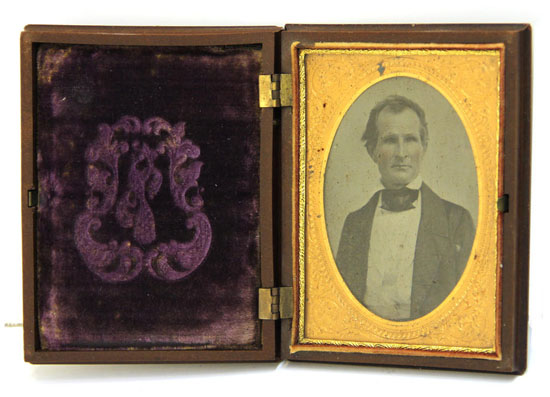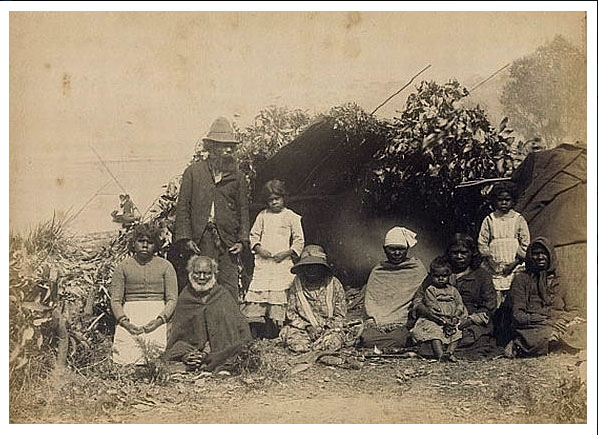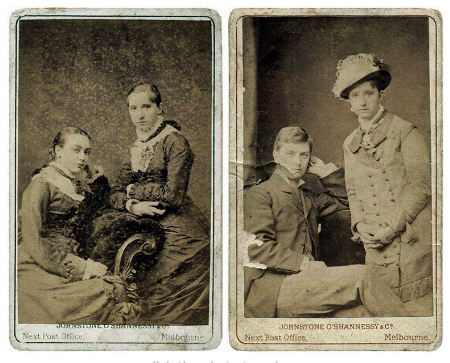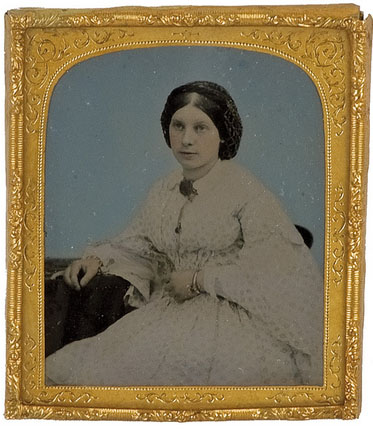Learn about antiques and collectables...
Click on a category below to show all the entries for that category.
Learn about and understand the items, manufacturers, designers and periods as well as the specialist terms used in describing antiques and collectables. Either click one of the letters below to list the items beginning with that letter, or click on a category on the left side of the screen to list the items under that category.
Albumen Prints
Albumen is the material found in egg whites, and used to make meringues. However in 1850 the Frenchman Louis Desire Blanquart-Evrard invented a method creating a photographic image using egg whites as a binder, together with silver nitrate and other chemicals, and the albumen print was born.
The albumen print became the dominant photographic printing process for the next fifty years, until the technique was superceded by the introduction of Kodak's Brownie camera.
Characteristics of albumen prints are the surface gloss, a reddish brown or purple image tonings and sometimes a cracking of the albumen binder.
Ambrotype
An early type of photograph made by imaging a negative on glass backed by a dark surface such as paper or black varnish. The process was only in use for about 10 years from 1855 to 1865.
Caire, Nicholas
Nicholas John Caire was born in 1837 in Guernsey, Channel Islands. He migrated to Australia with his parents and arrived in Adelaide about 1860.
He had developed an interest in photography from a young age and with help and instruction from a local photographer soon becam competent in the art.
By his late twenties he was travelling and photographing through Gippsland.
In 1867 he opened a studio in Adelaide.
After marrying in 1870 he and his wife moved to Talbot, near Clunes, Victoria, where he worked for the next six years.
In 1876 when he bought an established studio in Collins Street, Melbourne but in 1885 he gave up his city studio and devoted the rest of his life to outdoor photography, working from his home in South Yarra.
He died at Armadale, Victoria, in 1918.
Carte De Visite
The carte de visite was a standard size small albumen photograph, that when mounted on a thicker paper card, measured 2.5 inches (64mm) by 4 inches (100mm).
The advantage over previous methods of photographic reproduction that allowed for only a single reproduction at a time, was that the inventor, Frenchman Adolphe Disderi had patented a photographic method in 1854 using the 'multiplying camera-obscura', that took multiple separate negatives on a single plate thus reducing production costs. Later versions of this camera took 8 and then 12 negatives on a single plate.
The format and cheaper cost meant that for the first time it was economical for relatives and friends to exchange portraits either by hand or by post, no matter where they were located, and from about 1859 their use spread from Paris to other areas of Europe and the Americas.
The popularity of the carte de visite was enhanced through their use by the ruling classes. In 1859 in France photographs of the Emperor Napoleon by the inventor of the carte de visite, Disden, made the first more popular, and the second famous. In England in 1860, a set of 14 portraits of the Royal Family, comprising Queen Victoria, Prince Albert and their children bound into a Royal Album was an immediate success, and hundreds of thousands were sold. During the Civil War in America photos of Abraham Lincoln, Ulysses S. Grant, and other celebrities of the era were instant hit in the North..
Most cartes de visite depict individuals or groups in a studio setting, although some landscape examples do exist.
However the era of the carte de visite was short-lived. After the peak period of popularity between 1863 and 1877, production waned. Other types of photographs, such as the larger cabinet card slowly replaced the carte de visit as the preferred method of recording family portraits. Both the carte de visite and cabinet card became redundant with the invention of the Brownie camera by Kodak in the 20th century, and the services of a professional photographer were no longer required to produce a photograph.
Charles P. Mountford
Charles Mountford was born at Hallet, South Australia in 1890. He left school at the age of 11 and worked in a variety of jobs before seeking education to further his knowledge of Aboriginal Australia. He studied Aboriginal folklore and history at the University of Adelaide and later at Cambridge University. Between 1937 and 1960 he led 12 scientific expeditions to CentraI Australia, Arnhhem Land and Melville Island chronicling his travels in more than 20 books, numerous articles supported by photographs and films of Aboriginal art and ritual. Over the course of his career he was Honorary Ethnologist to the South Australian Museum, Honorary Adviser on Aboriginal art to the South Australian Art Gallery and a foundation member of the Australian Institute of Aboriginal Studies in Canberra. In 1973, the Council of the University of Melbourne awarded him an honorary doctorate for his lifetime of contribution to the study of Aboriginal art and mythology. Charles Mountford died in Adelaide on16 December 1976.
Christmas Cards
With the establishment of the public postal service in 1840, the first 'Penny Post' postal deliveries began. Before that, only the very wealthy could afford to send articles by post. The new Post Office was able to offer a Penny stamp because new railways that could carry larger quantities of freight, were being built.
Sir Henry Cole, a civil servant was very interested in the new public postal service, and he is credited with originating the idea of Christmas cards in order to make use of the new postal service.
Cards could be mailed for half a penny, half the price of an ordinary letter, and as printing methods improved they were produced in large numbers from 1860.
The idea spread gradually to other countries and, by 1890, the volume of Christmas cards had reached such proportions that postal administrations had to make special arrangements for the handling of such mail.
The first cards usually had pictures of the Nativity scene on them. In late Victorian times, robins and snow-scenes became popular. There was a fashion for elaborate cards, composed of scraps, silk vignettes and lace ribbons, in the later 1800s and then the fashion moved to novelty cards with pop-up pictures or animated devices. From 1900 up to the First World War, Christmas cards in the form of picture postcards were fashionable. Floral compositions or real photographs of very young children were favourite subjects.
Daguerreotype
The first photographic image was achieved in 1814 by Frenchman Joseph Niepce, with first photographic with the camera obscura, an optical device that projects an image onto a screen. However, the image required eight hours of light exposure and later faded.
Joseph Niepce continued working on improving his invention Louis-Jacques-Mandé Daguerre, an artist. Niepce died in 1833, but Daguerre carried on, and at a meeting of the French Academy of Sciences in Paris on August 19, 1839 announced he had discovered a new method of photography, the daguerreotype which he named after himself. The daguerreotype process reduced the exposure time from 8 hours to 3 - 15 minutes.
In major cities, professional photographers of the time, known as daguerreotypists, invited celebrities and political figures to their studios, hoping that by displaying a selection of portraits in their windows, the public would be encouraged to be photographed.
However the popularity of the daguerreotype was short-lived, and its use declined in the late 1850s when the ambrotype, a faster and less expensive photographic process, became available. However the ambrotype still required the services of a professional photographer and it was not until the invention of Kodak's Box Brownie in 1900 that the public were able to shoot their own photographs.
Due to the short time (20 years) that the daguerreotype was popular, and the fact that the image was produced directly onto the plate, meaning there were no negatives, original daguerreotypes are scarce. Most daguerreotypes are portraits, with landscapes and street scenes being less less common.
Willem Blaeu and Joan Blaeu, Cartographers
Willem Janszoon Blaeu (1571-1638) and Joan Blaeu (1596-1673) were father and son map makers, astronomers, and cartographers from the Netherlands. They are considered to be among the most important figures in the history of cartography and are known for their detailed and accurate maps of the world.
Willem Janszoon Blaeu, who was born in Alkmaar, Netherlands, studied cartography, astronomy and mathematics in Amsterdam, later established himself as a globe and instrument maker, after that he started to publish maps and atlases. In 1630, he established a cartographic printing press in Amsterdam, which was one of the largest and most advanced of its kind in Europe. He is considered to be one of the founders of the Dutch school of cartography, which was known for its highly detailed and accurate maps.
Joan Blaeu, Willem's son, worked with his father in the cartographic printing press, and after his father's death in 1638, he took over the business and continued to produce maps and atlases. He published many important works, including the "Atlas Maior," which was one of the most comprehensive and detailed atlases of the world that had ever been produced at that time, it was said to have contained around 593 maps and around 3,000 pages.
Both father and son's maps and atlases were widely used by sailors, merchants, and scholars, and they were considered to be among the most accurate and detailed maps of their time. They also contributed to the progress of knowledge, by adding new information and correcting errors in existing maps and by promoting new surveying and cartographic techniques.
View further examples of Willem Blaeu and Joan Blaeu, Cartographers




